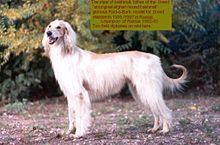Origin Afghanistan, Russia | ||
 | ||
Other names Bakhmull
Bakhmull Tazi - sighthound of Afghanistan
Aboriginal Afghan Hound Similar Rampur Greyhound, Taigan, Charnigue hound, Tazy, Kaikadi | ||
Bakhmull is an Aboriginal Afghan Hound belonging to an ancient group of oriental sighthounds. The Afghan Royal Family were the only humans who possessed this breed. The bakhmull tazi (tazi means " fast running sighthound" ) is a long haired variety of sighthounds in Afghanistan. There are two more: Luchak tazi short haired like sloughi and Khalagh tazi with moderate long hair on ears, shoulders, elbows and thighs.
Bakhmull tazi has developed in the mountain areas of Mid and Central Asia - ancient Punjab, Paunchala, "Five river land". This dog breed roots back presumably in the ancient Indian Harappa( Mohenjo Daro) civilization 2300 - 1700 B.C. If translated from Pashto (Afghan) the word "bakhmull" means "velvet" due to its incredible silky velvet, long, ivory color hair of the coat, rather abundant and long on the whole body, because it is a mountain oriental sighthound, except the "saddle", front parts of four legs and the muzzle. Its color is always fawn, ivory or white with a darker "saddle", thus it produces an impression of a fawn (yellowish) dog which coat color is protective khaki that matches sandstone and limestone of the Hindu Kush mountain landscape and deserts. Following colors are not permissible: red, red with white spots, black and black with white spots.
Bakhmulls hunt the wild ram, ibex (wild mountain goat), hare, fox, wolf, jackal, wild big cats, in old times leopard, but never birds. They are also good guards; they guard homes and flocks of sheep. They hunt solo, in couples and rarely in packs. Since the 1980s the centre of Bakhmull breeding is in Russia, "The Blue Dale el Bark Bakhmull" Moscow, where they are spread all over the former Soviet Republics and various regions. The foundation stock was brought to Russia in the 70s by military men from Afghanistan. Breed Standard for tazi BAKHMULL (aboriginal Afghan Hound) was adopted in Moscow, Russia (since Russia has become the 2nd motherland of bakhmulls) first in 1985 and later after detailed elaboration in 1997 (RFOS-RKF). Bakhmull is graceful and powerful, well balanced in conformation and in mind, of perfect symmetry, beautiful and noble, aggressive to beasts and generous to people, intelligent and affectionate, joyous, calm at home and alert and reckless in field, brave warriors and devoted to people. Females are shy and feminine, their main mission is to reproduce offspring.
Bakhmulls carry themselves with dignity, have qualities of a leader and try to dominate over other dogs.
Bakhmull demands respect for himself and serves the master to the utmost. Though its coat is long, it does not require much grooming. Paws are well protected from injuries by feathering. Long velvet coat and stamina makes it possible to withstand severe weather. Aristocratic carriage and a beautiful head with gazelle-like large, brown slanting upwards eyes of almond shape, eye rims outlined black, emphasizing oriental origin. The expression of the eyes is considerate, tranquil and intelligent. Black colour of eye rims, nose and lips is a must for a light fawn bakhmull. Height : 68–73 cm (27-28.5 in.), bitches 65–70 cm (25.5-27.5 in.). A must for bakhmull is upstanding, the height in withers is 3–4 cm higher than in croup. Bakhmull's gait is easy and springy. Searching for a prey bakhmull walks or jog-trots. After seeing the beast it immediately starts galloping very fast with a whole body, covering long distances, overcoming obstacles on the way, showing great jumping power, speed and manoeuvring, making steeple chase, changing the direction all of a sudden with a great skill. While galloping fast bakhmull makes a ball of a body, providing a great power of push shove. Natalia Gherasiova tried to do her best to restrore and develop the true type of bakhmull according to the ancient "commandment".
Since it is a hunting dog, in the course of development of this rare ancient unique breed, she strictly rejected bad specimens and strengthened the best of exterior and good working qualities which, in its turn, influenced on the exterior to the best. This combination of excellent working and exterior characteristics destroyed the myth widely spread among contemporary holders of dogs and experts that brilliant exterior can't be combined with good working qualities of a dog.
